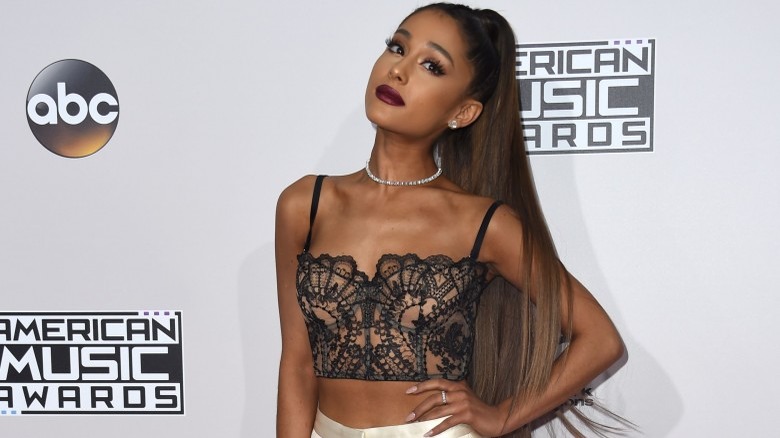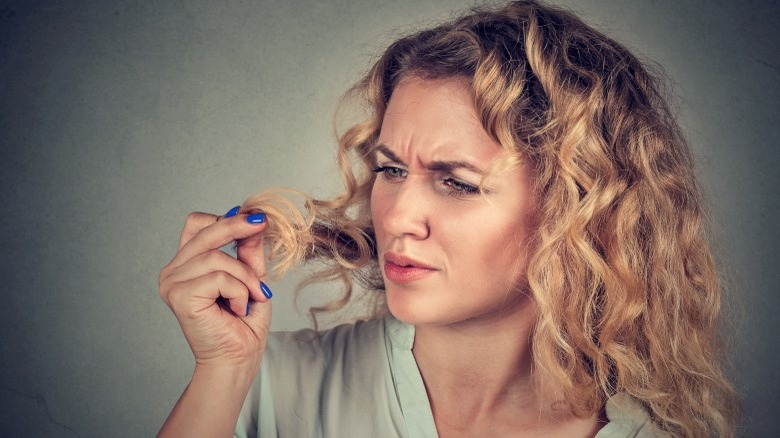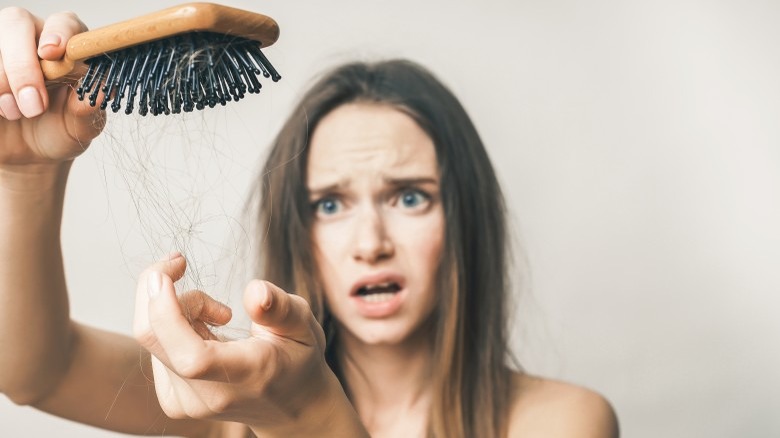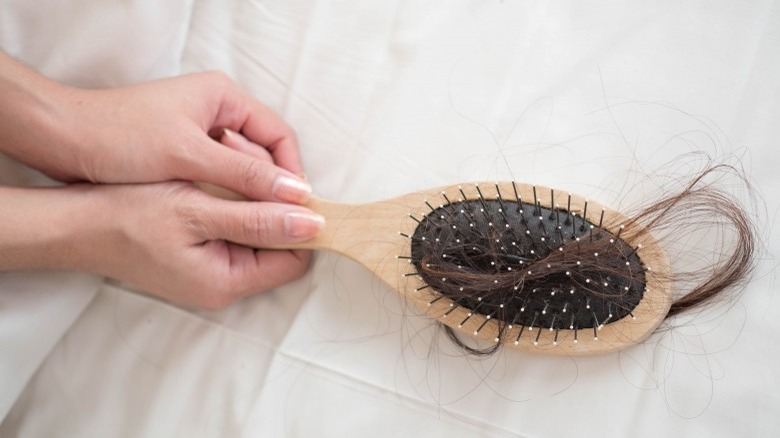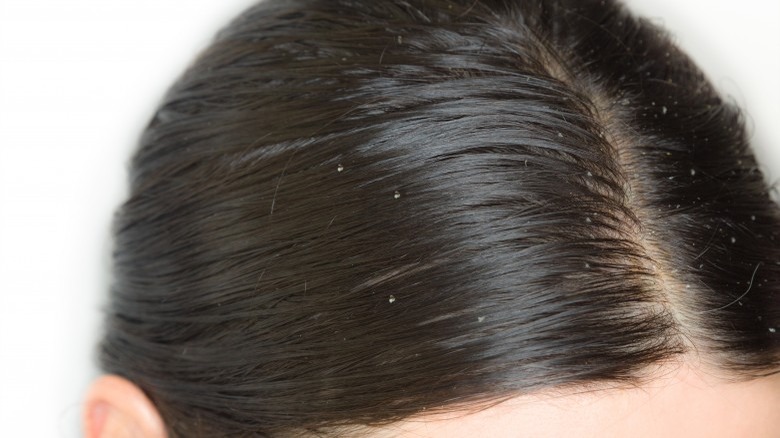Surprising Reasons Your Hair Is Falling Out
Realizing your hair is falling out is terrifying and awful, especially as a woman. Your mane is often a symbol of your femininity, and a token of your beauty, so to lose any of that can be incredibly stressful. The good news is, you may be able to reverse, or at least slow the process, if you can narrow down the cause.
And before you panic, know that a bit of daily hair loss isn't cause for alarm. "Hair loss in women is, to a certain extent, normal," hair restoration specialist Dr. James C. Marotta told StyleCaster. "The average woman loses between 50 and 100 strands per day — even up to 150 in some cases." Phew!
So when should you worry? Dr. Marotta recommends a test you can do yourself, to see if your hair loss is cause for concern. "Take about 60 hairs between your fingers and pull, running your fingers through your hair. Usually between 5 and 8 hairs [will come out], which is normal," he said. "An excess of 15 hairs, however, is not as common, and means you are losing more hair than you should be."
If you're in the 15 and over camp, read on to find out what may be the culprit, so you can recover those lush, full locks again, stat.
Over-styling hair and using too many products
Over-styling your hair, whether it's over-brushing, overuse of heat tools, or even overusing some long-hold hair products, can cause breakage. This may make it look like your hair is falling out — but it's actually breaking off of the ends or the shaft, not coming out at the roots.
"Hair myths, such as brushing your hair one hundred strokes each day, can cause split ends," board-certified dermatologist Dr. Paradi Mirmirani told the American Academy of Dermatology. "Having healthy hair is possible if you know how to care for your hair before and after styling." Dr. Mirmirani recommends towel or air-drying hair, brushing as little as possible, avoiding long-hold styling products, and setting styling tools to low or medium heat.
Wearing the same hairstyle all the time
Are you committed to your extensions, top knot, or high ponytail, a la Ariana Grande? If so, you may have "traction alopecia," a condition that occurs after "persistent gentle pulling on the roots, over several hours or days," The Independent reports. Exactly where the hair loss occurs can depend on what style you prefer: if you apply rollers too tightly, you may get a somewhat irregular traction alopecia pattern, while those who prefer top knots may get a horseshoe-shaped pattern of hair loss. Those who opt for cornrows or braids may find they lose hair along their parts. Ladies who prefer ponytails may see hair falling out on the sides of their foreheads.
If this is the cause, the remedy is somewhat simple, if gradual. Dr. Mirmirani suggests taking breaks from cornrows, braids, extensions, or any other super-tight styles, to allow your hair a chance to grow back. Even simply switching up your part can help.
Your hormones
A hormonal imbalance can cause levels of hair-growing hormones (like estrogen and progesterone) to dip, and hair-loss hormones (like androgen and testosterone) to rise, Women's Health reports.
What's important here is to determine the cause of the hormonal imbalance itself: you may have a thyroid issue, polycystic ovary syndrome, or simply benefit from medication that regulates hormones, like birth control. Once your doctor determines the cause, he or she can develop the best plan of action to correct (or at least minimize) the problem.
Your birth control
Birth control can solve so many problems when you find the right formula. Your cramps are reduced, your mood swings aren't as severe, your skin may clear up — and hopefully, you'll keep your hair.
Stopping or starting birth control in general can sometimes cause hormonal fluctuations that can trigger hair loss, and endocrinologist Dr. Geoffrey Redmond explained to The Daily Beast that certain formulations of birth control are more likely to cause hair loss than others.
"The pill has two types of hormones in it, or most of them do: a form of estrogen, which is good for hair, and a progestin, which is a modified form of progesterone, and those vary in their androgenic activity," Dr. Redmond said. "The two situations which might give rise to hair loss over the pill are, first of all, if someone is on an androgenic progestin, of which the norethindrone in Loestrin is one of them, and norgestrel, which is in a variety of other pills...that's the one that's most androgenic."
Translation: If you're concerned about hair loss stemming from your birth control prescription, talk to your OBGYN about an anti-androgen formula. It may take some trial and error to find a method that's perfect for you. If changing your oral contraceptive isn't an option, Dr. Redmond also suggests adding an anti-androgen medication to counteract any potential hormonal hair loss that may come with its use.
Physical trauma
A traumatic physical event, like childbirth, or an injury, can lead to disruptions in your hair's growth cycle and cause your hair to start falling out. Dermatologist Marc Glashofer explained to Health, "When you have a really stressful event, it can shock the hair cycle, [pushing] more hair into the shedding phase."
The good news, Dr. Glashofer noted, is that once your body recovers from whatever the trauma was, so will your hair growth cycle — so be patient!
Stress
Severe emotional stress can occasionally trigger hair loss, and can often accelerate hair loss that's already occurring, Dr. Glashofer notes. This can create a pretty brutal cycle, because, well, having your hair fall out is extra stressful.
Dermatologist Melissa Piliang told Women's Health that meditation, exercise, and healthy habits in general can help you get your hair growth cycle back on track in as little as half the time that loafing, stressing, and drowning your sorrows in a sleeve of Oreos would. So break out the spinach and get thee to a yoga studio!
Poor nutrition
Vitamin A is a tricky minx. Too little of it can lead to dry, brittle hair that can break off, but too much of it may lead to actual hair loss. Thankfully, the American Academy of Dermatology notes that once you get your vitamin A levels to the healthy range, regular hair growth will resume. Talk to your doctor about how much you should take, especially if you're currently taking any medications.
Too much vitamin A is no good, but too little of some other vitamins is just as bad. If your eating habits aren't the best, the American Academy of Dermatology recommends some improvements: More protein and iron, which you can get from meat, eggs, fish, and seafood. Vegetarian? Don't worry, you have options! Beans, nuts, fortified cereals, seeds, lentils, and spinach will all help.
Autoimmune disorders
Autoimmune disorders, including alopecia areata, can cause your hair to start falling out. These conditions occur when "the body gets confused," Dr. Glashofer explained. "The immune system sees the hair as foreign and targets it by mistake." Alopecia areata is treatable with steroid injections and medications like Rogaine, but regrown hair may fall out again. If you have another autoimmune disorder, like lupus, causing your hair loss, it may be permanent. If you think you're suffering from an autoimmune disease, it's important to get to a doctor immediately!
Certain medications
If you're being treated for another condition, and you notice you're losing your hair, talk to your doctor — it may be a side effect of a medication you're taking. Certain blood thinners, anti-depressants, anti-seizure medicines, gout medications, beta blockers, anabolic steroids, and blood pressure medications can cause hair loss.
Talk to your doctor to see if there may be alternative options for your particular condition and course of treatment.
Not shampooing enough
If you don't shampoo daily, but notice giant globs of hair in your shower drain when you do, you may just need to suds up more often. "When you don't shampoo — which would shed [hair] naturally as you wash — it means that the hair is just sitting on the scalp," dermatologist Dr. Francesca Fusco told Shape. "You'll see the accumulation when you do go to wash your hair."
To eliminate any build-up on your scalp, Dr. Fusco suggests cutting back on the dry shampoo, as well as treating yourself to a weekly scalp exfoliation, which is simpler than it sounds. Simply mix an exfoliant like sea salt, or even sugar, right into your daily shampoo!
A scalp condition
Some scalp conditions can hinder hair growth and actually result in your hair falling out. Dermatologist Pamela Jakubowicz told Prevention that these conditions can include seborrheic dermatitis (which can be caused by a yeast overgrowth, hormonal changes, or excessive oil production, and results in greasy flakes), psoriasis (an autoimmune condition that produces thick white scales on the skin), or ringworm (which can manifest as scales or blisters on the scalp).
A dermatologist can determine the cause and treatment for these conditions and get your growth cycle back on track.
The changing seasons
Believe it or not, living in a temperate climate can actually trigger your shedding. Dr. Fusco explains, "Whenever the climate changes, your body goes through an adjustment period that can throw off your hair growth cycle. Since hair tends to grow faster in the summer, it's only natural to experience more shedding at the end of it."
If you feel like a molting ostrich every September, this may be the cause — so it's no cause for panic!
What to do if you're losing your hair now
You already know that checking in with a doctor to narrow down your causes and treat the underlying problems that can lead to your hair loss, is the most important step you can take to fix the problem. But what can you do in the meantime to at least hide the problem? Somewhat surprisingly, stylists recommend chopping a lot of your hair off, because shorter hair tends to look fuller and healthier than longer styles, which can look stringy if your hair is thinning.
Don't want to get a pixie just yet? Fret not, you have options! Hairstylists recommend adding layers to your mane and rocking deep side parts or jagged parts to give the illusion of more fullness. Bobs can be your best friend, especially if they're angled, because they're designed to look best sleek and flat — which means you won't have to spend an hour in front of the mirror everyday. Even bangs may be your new best friend — even if you don't have naturally straight hair.
As far as styling products, look for volumizing mousses and root lifters, which can create volume in limp strands. Just be sure to wash your hair thoroughly and regularly, otherwise product residue might weigh your hair down, counteracting the benefits.
Coloring your hair can also make it look fuller, because experts say it can swell your hair's cuticle, giving it the look of more volume. The key is to color your hair safely: see a professional to avoid doing damage that can cause breakage. You can also look for hair fibers and root sprays in colors close to yours, to camouflage a wider part or visible scalp.
Don't lose hope: new developments in hair loss treatment are being discovered everyday, so chances are you won't have to deal with this forever. And until then, you now have the tools you need to feel your best!


